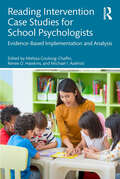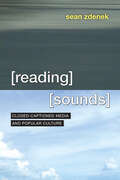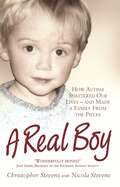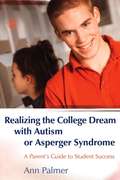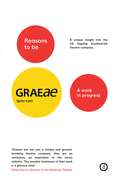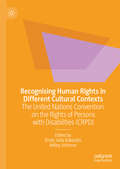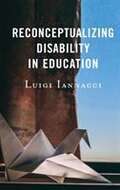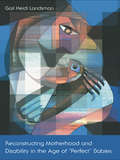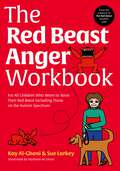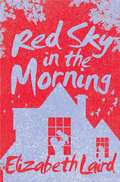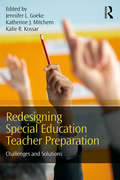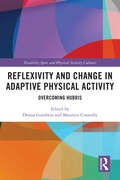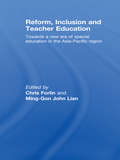- Table View
- List View
Reading Intervention Case Studies for School Psychologists: Evidence-Based Implementation and Analysis
by Melissa Coolong-Chaffin Renee O. Hawkins Michael I. AxelrodReading Intervention Case Studies for School Psychologists provides vivid, real-world examples of school-based interventions targeting students’ phonological awareness, phonics, fluency, and comprehension in reading. This book offers a rich variety of applied reading interventions in school settings , spanning strategies such as incidental teaching, word boxes, peer tutoring, taped words, story mapping, and beyond. Each case includes thorough descriptions of the specific area of concern, detailed intervention protocols, data collection and analysis methods, and tips for ensuring social acceptability and treatment integrity. School psychologists, along with related professionals in special education, general education, and speech-language pathology, will come away with new insights into this comprehensive set of well-researched and frequently applied reading interventions.
Reading Sounds: Closed-Captioned Media and Popular Culture
by Sean ZdenekImagine a common movie scene: a hero confronts a villain. Captioning such a moment would at first glance seem as basic as transcribing the dialogue. But consider the choices involved: How do you convey the sarcasm in a comeback? Do you include a henchman’s muttering in the background? Does the villain emit a scream, a grunt, or a howl as he goes down? And how do you note a gunshot without spoiling the scene? These are the choices closed captioners face every day. Captioners must decide whether and how to describe background noises, accents, laughter, musical cues, and even silences. When captioners describe a sound—or choose to ignore it—they are applying their own subjective interpretations to otherwise objective noises, creating meaning that does not necessarily exist in the soundtrack or the script. Reading Sounds looks at closed-captioning as a potent source of meaning in rhetorical analysis. Through nine engrossing chapters, Sean Zdenek demonstrates how the choices captioners make affect the way deaf and hard of hearing viewers experience media. He draws on hundreds of real-life examples, as well as interviews with both professional captioners and regular viewers of closed captioning. Zdenek’s analysis is an engrossing look at how we make the audible visible, one that proves that better standards for closed captioning create a better entertainment experience for all viewers.
Reading Sounds: Closed-Captioned Media and Popular Culture
by Sean ZdenekImagine a common movie scene: a hero confronts a villain. Captioning such a moment would at first glance seem as basic as transcribing the dialogue. But consider the choices involved: How do you convey the sarcasm in a comeback? Do you include a henchman’s muttering in the background? Does the villain emit a scream, a grunt, or a howl as he goes down? And how do you note a gunshot without spoiling the scene? These are the choices closed captioners face every day. Captioners must decide whether and how to describe background noises, accents, laughter, musical cues, and even silences. When captioners describe a sound—or choose to ignore it—they are applying their own subjective interpretations to otherwise objective noises, creating meaning that does not necessarily exist in the soundtrack or the script. Reading Sounds looks at closed-captioning as a potent source of meaning in rhetorical analysis. Through nine engrossing chapters, Sean Zdenek demonstrates how the choices captioners make affect the way deaf and hard of hearing viewers experience media. He draws on hundreds of real-life examples, as well as interviews with both professional captioners and regular viewers of closed captioning. Zdenek’s analysis is an engrossing look at how we make the audible visible, one that proves that better standards for closed captioning create a better entertainment experience for all viewers.
Reading Sounds: Closed-Captioned Media and Popular Culture
by Sean ZdenekImagine a common movie scene: a hero confronts a villain. Captioning such a moment would at first glance seem as basic as transcribing the dialogue. But consider the choices involved: How do you convey the sarcasm in a comeback? Do you include a henchman’s muttering in the background? Does the villain emit a scream, a grunt, or a howl as he goes down? And how do you note a gunshot without spoiling the scene? These are the choices closed captioners face every day. Captioners must decide whether and how to describe background noises, accents, laughter, musical cues, and even silences. When captioners describe a sound—or choose to ignore it—they are applying their own subjective interpretations to otherwise objective noises, creating meaning that does not necessarily exist in the soundtrack or the script. Reading Sounds looks at closed-captioning as a potent source of meaning in rhetorical analysis. Through nine engrossing chapters, Sean Zdenek demonstrates how the choices captioners make affect the way deaf and hard of hearing viewers experience media. He draws on hundreds of real-life examples, as well as interviews with both professional captioners and regular viewers of closed captioning. Zdenek’s analysis is an engrossing look at how we make the audible visible, one that proves that better standards for closed captioning create a better entertainment experience for all viewers.
Reading Sounds: Closed-Captioned Media and Popular Culture
by Sean ZdenekImagine a common movie scene: a hero confronts a villain. Captioning such a moment would at first glance seem as basic as transcribing the dialogue. But consider the choices involved: How do you convey the sarcasm in a comeback? Do you include a henchman’s muttering in the background? Does the villain emit a scream, a grunt, or a howl as he goes down? And how do you note a gunshot without spoiling the scene? These are the choices closed captioners face every day. Captioners must decide whether and how to describe background noises, accents, laughter, musical cues, and even silences. When captioners describe a sound—or choose to ignore it—they are applying their own subjective interpretations to otherwise objective noises, creating meaning that does not necessarily exist in the soundtrack or the script. Reading Sounds looks at closed-captioning as a potent source of meaning in rhetorical analysis. Through nine engrossing chapters, Sean Zdenek demonstrates how the choices captioners make affect the way deaf and hard of hearing viewers experience media. He draws on hundreds of real-life examples, as well as interviews with both professional captioners and regular viewers of closed captioning. Zdenek’s analysis is an engrossing look at how we make the audible visible, one that proves that better standards for closed captioning create a better entertainment experience for all viewers.
Reading Sounds: Closed-Captioned Media and Popular Culture
by Sean ZdenekImagine a common movie scene: a hero confronts a villain. Captioning such a moment would at first glance seem as basic as transcribing the dialogue. But consider the choices involved: How do you convey the sarcasm in a comeback? Do you include a henchman’s muttering in the background? Does the villain emit a scream, a grunt, or a howl as he goes down? And how do you note a gunshot without spoiling the scene? These are the choices closed captioners face every day. Captioners must decide whether and how to describe background noises, accents, laughter, musical cues, and even silences. When captioners describe a sound—or choose to ignore it—they are applying their own subjective interpretations to otherwise objective noises, creating meaning that does not necessarily exist in the soundtrack or the script. Reading Sounds looks at closed-captioning as a potent source of meaning in rhetorical analysis. Through nine engrossing chapters, Sean Zdenek demonstrates how the choices captioners make affect the way deaf and hard of hearing viewers experience media. He draws on hundreds of real-life examples, as well as interviews with both professional captioners and regular viewers of closed captioning. Zdenek’s analysis is an engrossing look at how we make the audible visible, one that proves that better standards for closed captioning create a better entertainment experience for all viewers.
Reading Sounds: Closed-Captioned Media and Popular Culture
by Sean ZdenekImagine a common movie scene: a hero confronts a villain. Captioning such a moment would at first glance seem as basic as transcribing the dialogue. But consider the choices involved: How do you convey the sarcasm in a comeback? Do you include a henchman’s muttering in the background? Does the villain emit a scream, a grunt, or a howl as he goes down? And how do you note a gunshot without spoiling the scene? These are the choices closed captioners face every day. Captioners must decide whether and how to describe background noises, accents, laughter, musical cues, and even silences. When captioners describe a sound—or choose to ignore it—they are applying their own subjective interpretations to otherwise objective noises, creating meaning that does not necessarily exist in the soundtrack or the script. Reading Sounds looks at closed-captioning as a potent source of meaning in rhetorical analysis. Through nine engrossing chapters, Sean Zdenek demonstrates how the choices captioners make affect the way deaf and hard of hearing viewers experience media. He draws on hundreds of real-life examples, as well as interviews with both professional captioners and regular viewers of closed captioning. Zdenek’s analysis is an engrossing look at how we make the audible visible, one that proves that better standards for closed captioning create a better entertainment experience for all viewers.
A Real Boy: How Autism Shattered Our Lives - and Made a Family From the Pieces
by Christopher Stevens Nicola StevensWe feel like parents in a fairytale turned to stone by a curse and condemned to stand like statues with our hearts thudding in our chests as our son plays wild games, all alone in the palace. He sees us he knows us, he expects us always to be in our right places - but he has no idea that we are human too. David is eleven years old. He is happy, healthy and affectionate. He loves school, climbing trees and Disney songs. But he's also profoundly autistic.Imagine being, like David, unable to speak more than a few words and unable to express your most basic needs. He is oblivious to danger and blind to other people's emotions, including the pleas of his parents. He is unaware of the chaos that he creates and is completely unmoved by the heartbreak that he causes. This extraordinarily moving account describes the heartbreak, and the unexpected joy, of autism. With raw honesty, Christopher and Nicola Stevens lay bare their experiences, which are by turns harrowing, hilarious, and inspirational.Autism is often depicted as a lonely affliction but, as David's story unfolds, his parents reveal how the condition has given them an unbreakable togetherness; an insight into prejudice, as well as kindness; an understanding of life without words or language; and an intense appreciation of their children. Caring for David is an all-consuming experience...and through it they have learned, most of all, the meaning of unconditional love.
Realizing the College Dream with Autism or Asperger Syndrome: A Parent's Guide to Student Success
by Ann PalmerRealizing the College Dream with Autism or Asperger Syndrome is both a practical and a personal account of one ASD student's successful experience of going to college. This accessible book focuses on how to get there and stay there: deciding to go, how to get in and how to get the most out of it. Ann Palmer advises parents and professionals how to prepare the student for the transition from school and home life to a new environment and educational challenge, and how to support them through potential problems such as academic pressure, living away from home, social integration and appropriate levels of participation in college. She offers helpful strategies that will encourage and inspire parents and students and show that college can be a suitable option for students with an autism spectrum disorder, as well as the basis for a successful independent life later. This book is essential reading for any parent considering college as an option for their child, disability service providers in colleges and for ASD students themselves.
Really Useful ASD Transition Pack
by Alis HawkinsUsing snippets of practice-based theory, this title provides an overview of considerations as diverse as sensory sensitivities and their impact on the school day, how interactions in the playground might be handled and whether the pupil is allowed to eat separately, as well as teaching and learning issues.
Really Useful ASD Transition Pack
by Alis HawkinsUsing snippets of practice-based theory, this title provides an overview of considerations as diverse as sensory sensitivities and their impact on the school day, how interactions in the playground might be handled and whether the pupil is allowed to eat separately, as well as teaching and learning issues.
Reasons to be Graeae: A work in progress
by Jenny SealeyGraeae is a force for change in world-class theatre, placing D/deaf and disabled actors centre stage and challenging preconceptions.A Work in Progress contains the full script of Reasons to be Cheerful, a brief history of the company, analysis and extracts from their previous shows, memories of Graeae from previous collaborators, including Jack Thorne, Jo Clifford, Kaite O’Reilly and Jonathan Meth, and a host of images.‘Graeae are not just a unique and groundbreaking theatre company; they are an institution, an inspiration to the entire industry. This overdue testimony of their work is a glorious read.’ Rufus Norris, Director of the National Theatre‘Graeae has always been a company in which radicalism and mischief have walked cheek by jowl. It’s a pleasure to see four decades of theatre celebrated.’ Lyn Gardner, The Guardian
Recognising Human Rights in Different Cultural Contexts: The United Nations Convention on the Rights of Persons with Disabilities (CRPD)
by Kelley Johnson Emily Julia KakoullisThis book explores the journey of the United Nations Convention on the Rights of Persons with Disabilities (CRPD) as it is interpreted and translated from International Human Rights Law into domestic law and policy in different cultural contexts. Beginning with reflections on ‘culture’, ‘disability’ and ‘human rights’ from different disciplinary perspectives, the work is then organised as ‘snapshots’ of the journey of the CRPD from the international level to the domestic; the process of ratification, the process of implementation, and then the process of monitoring the CRPD’s implementation in States Parties cultural contexts. Leading global contributors provide cutting-edge accounts of the interactions between the CRPD and diverse cultures, revealing variations in the way that the concept of ‘culture’ is defined. This collection will appeal to academics and students in Law and Socio-Legal Studies, Disability Studies, Policy Studies and Social Work, Sociology, Anthropology; and those training to be service providers with persons with disabilities.
Reconceptualizing Disability In Education (Critical Issues In Disabilities And Education Ser.)
by Luigi IannacciReconceptualizing Disability in Education provides an essential critical exploration of problematic discourses, practices, and pedagogies that inform how disability is presently understood and responded to within the field of education. Luigi Iannacci interrogates and destabilizes ableist grand narratives that dominate every aspect of how disability is linguistically, bureaucratically, procedurally, and pedagogically configured within education. Ultimately, this book seeks to forward human rights for people with disabilities in educational contexts by clarifying and operationalizing inclusion so that it is not just a model necessitated by a hierarchy of legality, but rather a set of beliefs and practices based on critical analyses and a reconceptualization of current understandings and responses to disability that prevent inclusion and human rights from being realized. As the book is grounded in reconceptualist theorizing, it draws on multiple perspectives-including critical disability theory, post-modernism, critical theory, critical pedagogy, and social constructivism-to deconstruct and destabilize what is currently taken for granted about disability and those ascribed disabled identities within education. A variety of personal, professional, research experiences and data are offered and drawn on to critically address questions regarding philosophical, epistemological, pedagogical, organizational, economic, and leadership issues as they relate to disability in education. Critical incidents, interviews, documents, and artifacts are drawn on and narratively presented to explore how disability is presently configured in language, identification, and placement processes, discourses, pedagogies, and interactions with students deemed disabled, as well as their parents/caregivers. This critical narrative approach fosters alternative ways of thinking, speaking, being, and doing that forward a human rights focused model of disability that sees as its mandate the amelioration of people with disabilities within education.
Reconstructing Motherhood and Disability in the Age of Perfect Babies
by Gail LandsmanExamining mothers of newly diagnosed disabled children within the context of new reproductive technologies and the discourse of choice, this book uses anthropology and disability studies to revise the concept of "normal" and to establish a social environment in which the expression of full lives will prevail.
Reconstructing Motherhood and Disability in the Age of Perfect Babies
by Gail LandsmanExamining mothers of newly diagnosed disabled children within the context of new reproductive technologies and the discourse of choice, this book uses anthropology and disability studies to revise the concept of "normal" and to establish a social environment in which the expression of full lives will prevail.
The Red Beast: Controlling Anger in Children with Asperger's Syndrome (PDF)
by Haitham Al-Ghani Kay Al-GhaniDeep inside everyone, a red beast lies sleeping. When it is asleep, the red beast is quite small, but when it wakes up, it begins to grow and grow. This is the story of a red beast that was awakened. Rufus is in the school playground when his friend John kicks a ball that hit him in the stomach, and wakes up the sleeping red beast: `I hate you - I'm gonna get you!'. The red beast doesn't hear the teacher asking if he's okay. It doesn't see that John is sorry - how can Rufus tame the red beast? This vibrant fully illustrated children's storybook is written for children aged 5+, and is an accessible, fun way to talk about anger, with useful tips about how to 'tame the red beast' and guidance for parents on how anger affects children with Asperger's Syndrome.
The Red Beast Anger Workbook: For All Children Who Want to Tame Their Red Beast Including Those on the Autism Spectrum
by Kay Al-Ghani Sue LarkeyThis illustrated and interactive workbook will help children find ways to calm their Red Beast and learn how to prevent it from waking in the first place. Full of practical activities and illustrated examples, it supports the development of emotional and sensory regulation and provides coping mechanisms for children who experience intense emotional flooding or meltdowns as well.The workbook includes a helpful introduction for adults on the science of self-regulation, clear guidance on how to pace the learning and a wide range of activities such as scenarios to help children explore their anger, anger management plans, and exercises that encourage interoceptive awareness. It also addresses common causes of anger including perfectionism, winning and losing and discusses the importance of a positive attitude and using kind words in a child-friendly way.Join Danni and his friends and family as they explore the challenges they face from the Red Beast and how they overcome them.
The Red Beast Anger Workbook: For All Children Who Want to Tame Their Red Beast Including Those on the Autism Spectrum
by Kay Al-Ghani Sue LarkeyThis illustrated and interactive workbook will help children find ways to calm their Red Beast and learn how to prevent it from waking in the first place. Full of practical activities and illustrated examples, it supports the development of emotional and sensory regulation and provides coping mechanisms for children who experience intense emotional flooding or meltdowns as well.The workbook includes a helpful introduction for adults on the science of self-regulation, clear guidance on how to pace the learning and a wide range of activities such as scenarios to help children explore their anger, anger management plans, and exercises that encourage interoceptive awareness. It also addresses common causes of anger including perfectionism, winning and losing and discusses the importance of a positive attitude and using kind words in a child-friendly way.Join Danni and his friends and family as they explore the challenges they face from the Red Beast and how they overcome them.
Red Sky in the Morning (New Windmill Ser.)
by Elizabeth LairdTwelve-year-old Anna is looking forward to the birth of her baby brother. Ben arrives, but is disabled and will never be like other children. Anna loves him with her whole heart, but she finds herself unable to admit the truth of Ben's condition to her school friends. Eventually the truth gets out and leads not to the ridicule Anna expected, but to sympathy and understanding.An emotional and wonderfully written story by Elizabeth Laird, Red Sky in the Morning was Highly Commended for the Carnegie Medal.
Redesigning Special Education Teacher Preparation: Challenges and Solutions
by Jennifer L. Goeke Katherine J. Mitchem Kalie R. KossarRedesigning Special Education Teacher Preparation describes both challenges and possible solutions to redesigning and restructuring high-incidence teacher preparation programs so graduates will meet the Highly Qualified Teacher requirements and be prepared to teach students with high-incidence disabilities. This powerful new text discusses many possible reforms, including field-based teacher preparation, a focus on evidence-based core practices and teacher moves, collaboration with K–12 school-based partners as teacher educators, interdisciplinary collaboration across university faculty, and a grounding in current expectations for high-stakes accountability and program evaluation.
Redesigning Special Education Teacher Preparation: Challenges and Solutions
by Jennifer L. Goeke Katherine J. Mitchem Kalie R. KossarRedesigning Special Education Teacher Preparation describes both challenges and possible solutions to redesigning and restructuring high-incidence teacher preparation programs so graduates will meet the Highly Qualified Teacher requirements and be prepared to teach students with high-incidence disabilities. This powerful new text discusses many possible reforms, including field-based teacher preparation, a focus on evidence-based core practices and teacher moves, collaboration with K–12 school-based partners as teacher educators, interdisciplinary collaboration across university faculty, and a grounding in current expectations for high-stakes accountability and program evaluation.
Reflexivity and Change in Adaptive Physical Activity: Overcoming Hubris (Disability Sport and Physical Activity Cultures)
by Donna Goodwin and Maureen ConnollyThis provocative and challenging book argues for the vital importance of critical self-reflexion in the field of adaptive physical activity (APA). It makes a powerful case for embracing discussions of the harm caused by ableist assumptions of the ideal body, maximizing capabilities and perfecting normative based movement that dominate contemporary discourse in APA, and calls for more critical introspection about what APA is, how it’s performed, and what might be needed to bring a collaborative relational ethic to this field. The book focuses on two key themes. Firstly, how ableism as a foundational belief system of APA is present in the undergraduate curriculum, professional preparation, professional practice, and organizational policies. Secondly, how to make the comfortable uncomfortable by openly debating the harm that results from non-reflexive (nondisabled) hubris in APA. The goal is to spark an exchange of ideas among scholars, practitioners and organizational leaders, and therefore to shift the paradigm from one of professional expertism to one that centers disability wisdom holders, bringing a fundamental change to how we perform adaptive physical activity. This is important, progressive reading for anybody with an interest in adapted physical activity, adapted physical education, disability sport, inclusive education, the philosophy and ethics of disability and sport, or disability in wider society.
Reflexivity and Change in Adaptive Physical Activity: Overcoming Hubris (Disability Sport and Physical Activity Cultures)
by Donna Goodwin Maureen ConnollyThis provocative and challenging book argues for the vital importance of critical self-reflexion in the field of adaptive physical activity (APA). It makes a powerful case for embracing discussions of the harm caused by ableist assumptions of the ideal body, maximizing capabilities and perfecting normative based movement that dominate contemporary discourse in APA, and calls for more critical introspection about what APA is, how it’s performed, and what might be needed to bring a collaborative relational ethic to this field. The book focuses on two key themes. Firstly, how ableism as a foundational belief system of APA is present in the undergraduate curriculum, professional preparation, professional practice, and organizational policies. Secondly, how to make the comfortable uncomfortable by openly debating the harm that results from non-reflexive (nondisabled) hubris in APA. The goal is to spark an exchange of ideas among scholars, practitioners and organizational leaders, and therefore to shift the paradigm from one of professional expertism to one that centers disability wisdom holders, bringing a fundamental change to how we perform adaptive physical activity. This is important, progressive reading for anybody with an interest in adapted physical activity, adapted physical education, disability sport, inclusive education, the philosophy and ethics of disability and sport, or disability in wider society.
Reform, Inclusion and Teacher Education: Towards a new era of special education in the Asia-Pacific Region
by Chris Forlin Ming-Gon John LianThis ground-breaking book considers current perspectives on special education reform in the Asia-Pacific region. It has a major focus on a new era of special education, and how this relates to education reform towards inclusive education. With major changes being proposed under current educational reform and confusion as to how to instigate these measures, this book provides ways to better prepare teachers. It is helpfully divided into three different sections of education reform: "Education Reform in the Asia-Pacific region" reviews broad trends and issues in special education across the region, including Taiwan, Korea, Australia, India, China and Hong Kong. "Preparing Teachers to work in Inclusive Classrooms" focuses on curricula and pedagogical practices for teacher education. This section considers different approaches to preparing teachers such as cross-categorical, collaborative, innovations, and the impact of teachers’ attitudes, perceptions and concerns on inclusion. "Effective Special & Inclusive Practices" draws upon evidence–based research to provide best practice models to assist in developing inclusive school communities. Each section addresses a list of objectives and questions; suggests best practice pedagogy; and concludes with a support section with useful websites and suggested professional development activities. This book will interest teachers, teacher educators, university lecturers in education and post graduate students.
